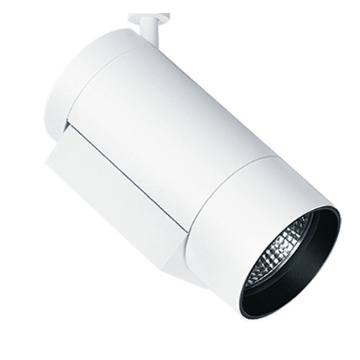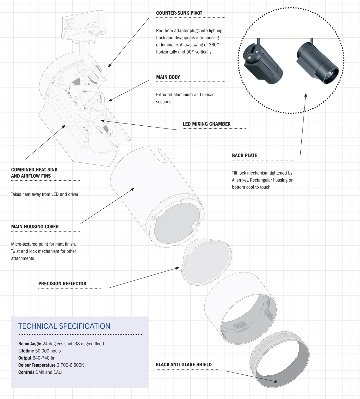
BDP Mark Ridler looks at Zumtobel Arcos Tunable White fitting with the firm marketing manager,Steve Shackleton, and discusses the best applications for the product. Peter Stuart reports
Lighting designers have long known how changing the colour temperature of lights can enhance the appearance of produce in retail applications and artefacts in museums, to name two examples. But shop displays and gallery exhibitions are temporary and soon those colder lights that were intended to bring out the bright primary colours in, say, the summer clothing range might not seem so appealing when that season fashion makes way for autumn shades.
The Arcos Tunable White from Zumtobel addresses this problem by allowing the user to tune the colour temperature of the light emitted without having to change the luminaire. In its simplest form, a dial can be turned on the back of the fitting to adjust colour temperatures between 2,700K and 6,000K.
The luminaire employs a PLED module developed by Tridonic and a specially developed mixing chamber to blend the light created by a combination of white, red and blue LEDs. Zumtobel claims that the difference between this luminaire and other tunable products is its ability to maintain a high colour rendering index throughout the changes in colour temperature. The company also says that the full range of colour temperature can be reproduced throughout the lifetime of the fitting.
Adopted by Harrods
So far, the Arcos Tunable White spotlight seems to be gaining traction in the retail sector. Harrods recently bought hundreds of units to light its toy department.
Mark Ridler said he could appreciate the retailer logic when he examined the fitting and discussed it with Zumtobel marketing manager Steve Shackleton.
The thing I love about it as a concept is that you could be at the top of a ladder pointing a light at an object and just change it to suit the task at hand. You don have to make the decision of having, say, a 3,000K fitting in advance: you can just do what right [for the conditions].
Museum and gallery spaces offer an equally clear application for the technology. After lighting designer Kevan Shaw saw the product at the Light+Building show in Frankfurt this year, he said: here is a serious lack of LED product for this niche area of lighting and it was a relief to find a manufacturer that had taken the challenge and made a product that addresses all the key requirements that lighting and exhibition designers require.
But Shackleton sees potential for the Tunable White technology in offices, too. He says: here I see great opportunities for tunable technology is in workplaces. I think the potential benefits are a bit harder to verbalise than they are in a shop or a museum but I really believe it could be the next big thing in lighting. He explains how Zumtobel is trying to employ Tunable White technology in its Panos Infinity downlight in office spaces: think we can do something with a better link to daylight and a better link to circadian rhythms, helping people to stay alert in the workplace and help their body clocks stay reasonably tuned.
Ridler is more cautious about the idea of circadian lighting, suggesting that the scientific research is not conclusive.
He says:I am very suspicious about applying different colour temperatures to workers to effect performance change. It incontrovertible that there is a circadian effect from light but we don know what the physiological impact on the organism is by manipulating it. I think that when we as artificial light designers start to muck about with the organism without understanding the biology enough, we e playing with fire.
Shackleton argues that a compromise might be to use the technology to create more comfortable office lighting in the evenings, or to use it to interact with daylight changes, rather than emulating them.
He says: I think using [tunable lighting] at the perimeter, lighting the columns and, particularly, window mullions is a good idea. Counter-intuitively, it better to have a higherbrightness mullion next to the window because of the contrast. The verticals can tend to dominate office spaces. So maybe things like the Panos Infinity could work quite nicely there.
Ridler is better disposed to this. This I agree with, using the technology to change the atmosphere of a place during the day, he says. instead of changing the colour temperature of the volume of the space, changing the play on vertical surfaces is very appealing.
Zumtobel Tunable White technology is available across a range of fittings, including the Arcos spotlight fitting (opposite) and the Panos Infinity downlight.
MARK VERDICT
Nice beam quality, flat with a soft transition. The tunability is also very appealing. I sceptical about using the technology for circadian effect but I think its ability to tune vertical surfaces in offices is promising. The retail and museum applications are obvious.






